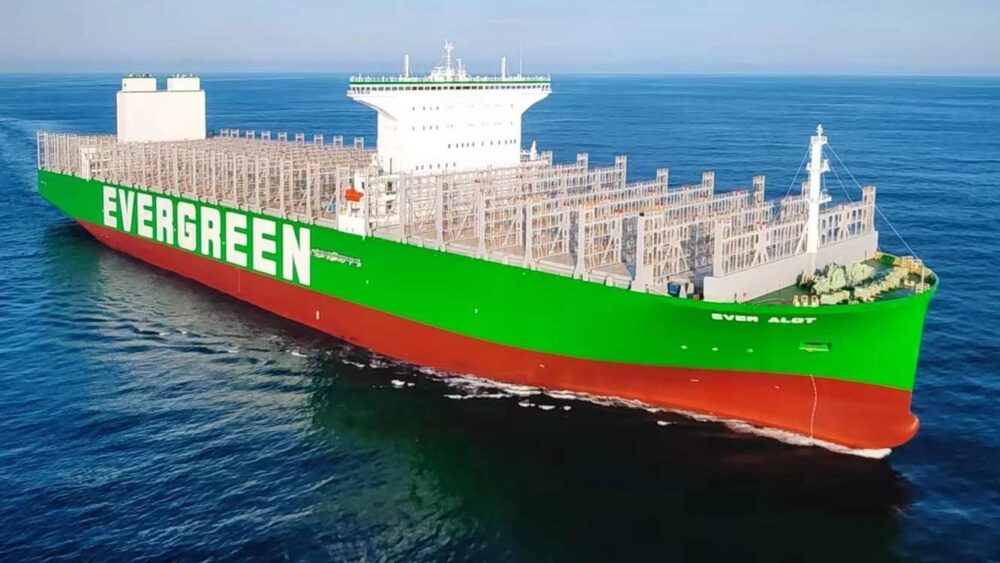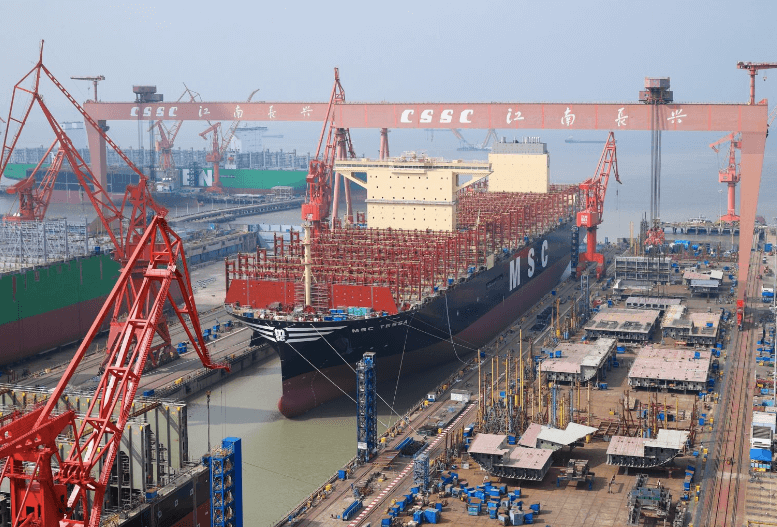 With a capacity of 24,004 TEU, the Ever Alot is the largest container ship ever built (CSSC).
With a capacity of 24,004 TEU, the Ever Alot is the largest container ship ever built (CSSC).
The new wave of container ships: Bigger? More sustainable?
The capacity of the container ship fleet is growing for the first time in many years. What do these new vessels look like? Will they continue to break capacity records? Are they more sustainable? We look at trends based on new vessel orders by the major shipping lines.

Carles Rúa is the Chief Innovation Officer at the Port de Barcelona and Director of the Master’s degree in Executive in Supply Chain Management at the UPC.

Javier Garrido is a researcher at the Center of Innovation and Transport (CENIT) and PhD student at Port de Barcelona.
 With a capacity of 24,004 TEU, the Ever Alot is the largest container ship ever built (CSSC).
With a capacity of 24,004 TEU, the Ever Alot is the largest container ship ever built (CSSC).
In June 2022, the Chinese shipyard Hudong Zhonghua Shipbuilding officially handed over to Evergreen the Ever Alot, the largest container ship ever built. With a capacity of 24,004 TEU, it is the first to break the 24,000 TEU barrier. The vessel was ordered in November 2019 and belongs to the Evergreen A-class, a series of 13 container ships ordered by the shipping line from three Asian shipyards. The MSC Tessa, with similar dimensions to the Ever Alot, but with a slightly larger capacity of 24,116 TEU, will be delivered shortly.
Will these two container ships set the trend for the industry? Will we continue to see bigger and bigger ships? What other innovations will come out of the shipyards in the coming years?
According to Alphaliner, in May 2022 there were about 900 container ships under construction or on order worldwide with a total capacity of 6.8 million TEU. Recent orders placed by shipping lines give us a clue to the evolution of the sector.
More container ships?
Based on the moves being made by the shipping lines, the answer is yes:
- In March 2021, Evergreen itself placed an order for 20 container ships of 15,000 TEU capacity to be delivered in 2024/2025.
- OOCL ordered in September 2021 ten new vessels with a capacity of 16,000 TEU each.
- MSC ordered in April 2021 four ULCS (Ultra Large Container Ship) of 24,100 TEU capacity to be delivered in 2023. In April this year, it expanded the order with fourteen new 8,000 TEU vessels and six additional 7,900 TEU units, to be delivered in 2025. In June, it added twenty new ships to the order, ten units of 8,100 TEU and the remaining ten of 11,400 TEU vessels.
- Lastly, CMA-CGM ordered in June this year six 15,000 TEU vessels to be delivered in 2025.
In fact, according to VesselsValue, as many as 561 containerships were ordered in 2021. Compared to the 114 in 2020 or the 107 in 2019, they mark a more than remarkable inflection from recent years’ trends. These orders allow us to see how the market for new vessels is evolving.
In contrast, the number of vessels destined for scrapping has been reduced. In fact, during the first half of 2022, and for the first time in many years, the number of fully cellular container vessels dismantled has been zero. This contrasts with the 16,500 TEU dismantled in 2020 or the much more significant 194,500 TEU in 2019.
This decrease is due to the current high freight rates. In other circumstances, ships with many years behind them would have become unprofitable and would have been sent to Asian beaches for dismantling. At current freight rates, however, they continue to provide profits for the shipping lines and therefore remain in operation.
The addition of new vessels put into operation and the reduction in scrapping will result in a significant net growth of the fleet in the coming years.
Thus, in 2023 we will begin to see a substantial increase in maritime transport supply that will consolidate in 2024 and 2025. This increase will foreseeably be significantly higher than the growth in demand and, therefore, will have an impact on the market and, possibly, on the reduction of freight rates.
And all this despite the fact that in recent months the increase in the price of materials, mainly steel, and energy have increased the cost of building container ships by 30-35%, according to Alphaliner.

According to VesselsValue, as many as 561 container ships were ordered in 2021, compared to 114 in 2020 or 107 in 2019
Bigger container ships?
The appearance of Maersk's E-Class in 2013 started a race among the major shipping lines for larger vessels. The capacity of the largest container ship now exceeds by 60% the capacity of the largest 10 years ago. Is this trend continuing?
In the second half of 2020, a new wave of new shipbuilding began. At that time, it concentrated on two extreme market segments: on the one hand, the "megamax" of around 24,000 TEU, and on the other hand, small feeders for regional trade, especially in Asia.
Looking at recent orders, from the second quarter of 2021 onwards, we may see a change in trend with the focus on medium-large vessels:
- Indeed, according to Clarksons AIR, in May 2022 a total of 221 vessels in the 12000-17000 TEU segment were on order, which would represent an increase of 72% of the current existing fleet in this segment.
- In contrast, orders for larger vessels (+17,000 TEU) amount to 52 units, equivalent to 36% of the current existing fleet.
- The segment with the most moderate growth would be the medium-sized vessels (between 8,000 and 12,000 TEU) whose number of orders represents "only" an increase of 5.4% over the current fleet.
- It is interesting to note that vessels between 4,000 and 8,000 TEU, which had virtually ceased to be built since 2014, are making a strong comeback on the market.
This shows that, in recent months, more interest has been generated in the more versatile vessels as opposed to ULCS of more than 20,000 TEU. If this trend is consolidated in terms of orders for the coming years, it would mean that, perhaps, the current size of large ULCS may be reaching its commercial, not technological, operational limit.
In fact, as already noted in 2020 in the scientific article “Predicting the Future Capacity and Dimensions of Container Ships”, no substantial growth in the size of container ships is expected, with the estimated limit being 30,000 TEUs for several reasons:
- The physical constraints of routes and ports.
- Exhaustion of the economies of scale in shipping costs.
- Global economic and demand trends.
More sustainable container ships?
The decision of the International Maritime Organisation (IMO) to limit the sulphur content of marine fuel oil, which came into force in January 2020, and its ambition to reduce greenhouse gas emissions by 50% by 2050, means that ships will have to be powered by new types of fuels.
In addition, the European Commission, with its ambitious plan derived from the European Green Deal known as ‘Fit for 55’, is considering various measures to reduce GHG emissions in the maritime sector. These include the introduction of the latter into the European Emissions Trading Scheme (ETS) and the 'Fuel UE' initiative to introduce more sustainable fuels for ships.
So far, the first transition fuel to be used commercially has been LNG (liquefied natural gas). However, although it solves the first problem, it is still a fossil fuel. Long-term alternatives focus on hydrogen and its carriers, especially methanol and ammonia, or electric propulsion. But what do the new ship orders underway tell us?
Obviously, battery-based electric propulsion can only be used, with existing technology, on smaller ships and on very short journeys, never for transoceanic voyages. One example is the 120 TEU container ship Yara Birkeland, which operates in Norwegian waters on a trip of just 18 km.
The six new CMA CGM vessels will use dual fuel-methanol engines. It should be recalled that CMA CGM had so far made a commitment to LNG when in 2017 it announced the decision to operate nine new 23,000 TEU vessels using this alternative fuel.
However, the use of ammonia or methanol is, so far, anecdotal. The only commercially viable alternative fuel today is LNG. There are currently 36 container ships in operation using it as fuel, but 169 more are on the way. By contrast, only a handful of methanol or ammonia-compatible ships are planned.
And between methanol and ammonia, methanol seems to have the winning hand. Indeed, major engine manufacturers such as MAN already have solutions available. On the other hand, ammonia engines are not expected until 2024 or 2025. This is due, in part, to the challenges the latter presents in terms of safety and the high energy requirements for ignition.
Are the economies of scale of mega-ships beneficial for the environment?
On the other hand, what we can analyse from MRV Thetis data and Lloyd's data, is that for vessels with a capacity of more than 8,000 TEU, CO2 per transported cargo is less than 20 g CO2/mton-nmile, thanks to economies of scale.
This shows that large-scale shipping is beneficial and even substantially more sustainable compared to other modes of transport such as trucks or aircraft powered by fossil fuels.
However, for mega-ships of 24,000 TEU, CO2 emissions per unit of cargo transported are very similar to those of 14,000-16,000 TEU. This may also be influenced by the fact that some intermediate-large ships are adapting to alternative fuels.
In conclusion, it is important to note that the ideal size of container ship will depend very much on global demand, which may vary significantly with company relocation processes. It will also depend on the energy mix, which is affected by high volatility as a result of the technological changes that will come to address climate change.





